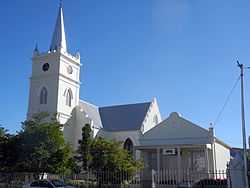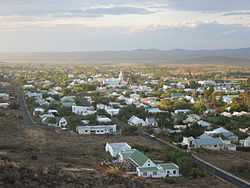Prince Albert, Western Cape
| Prince Albert Prins Albert | |
|---|---|
|
View overlooking Prince Albert | |
 Prince Albert
| |
| Coordinates: 33°13′31″S 22°01′48″E / 33.22528°S 22.03000°ECoordinates: 33°13′31″S 22°01′48″E / 33.22528°S 22.03000°E | |
| Country | South Africa |
| Province | Western Cape |
| District | Central Karoo |
| Municipality | Prince Albert |
| Established | 1842[1] |
| Area[2] | |
| • Total | 37.70 km2 (14.56 sq mi) |
| Population (2011)[2] | |
| • Total | 7,054 |
| • Density | 190/km2 (480/sq mi) |
| Racial makeup (2011)[2] | |
| • Black African | 2.2% |
| • Coloured | 85.7% |
| • Indian/Asian | 0.2% |
| • White | 11.3% |
| • Other | 0.6% |
| First languages (2011)[2] | |
| • Afrikaans | 91.7% |
| • English | 4.7% |
| • Other | 3.6% |
| Postal code (street) | 6930 |
| PO box | 6930 |
| Area code | 023 |
Prince Albert, South Africa (spelt Prins Albert in Afrikaans) is a small town in the Western Cape in South Africa. It is located on the southern edge of the Great Karoo, nestled just below the Swartberg mountains.
History
Prince Albert was founded in 1762[3] on a farm called Queekvalleij that had been on loan to Zacharias and Dina de Beer since 1762[4]
Originally known as Albertsburg, when it obtained municipal status in 1845 it was renamed Prince Albert in honour of Queen Victoria's consort, Prince Albert of Saxe-Coburg.[4] Prince Albert was historically part of the Cape Colony.
During the latter part of the century, a nugget of gold was discovered on a farm in the area. Due to the fact that a similar occurrence had led to the Gold Rush in the Witwatersrand, this new discovery precipitated a similar population boom. However, the prosperity up North was not to be shared in Prince Albert and the gold mined turned out to be minimal.[4]
Due to its location, Prince Albert became a British garrison during the Second Boer War in 1899. The town became the site of several clashes between the English and the Boers during this period.[4]
Climate
Prince Albert enjoys a temperate climate with high temperatures in summer, with an average of 33–35 °C, and 17 °C in the winter months. Winter is sunny with colder temperatures and chilly nights, reaching midwinter minimums of 2 °C, with frost in places.
Points of interest
Prince Albert has a small local population, it survives today as a tourist town. The village has many authentic Cape Dutch, Karoo and Victorian buildings, thirteen of which are National Monuments. There are several olive farms and other very large export fruit farms in the area, as well as sheep farms, an export mohair trade, and each year the village celebrates the well-known Olive Festival. Birding, hiking, cycling and stargazing are other pursuits for visitors. The area is well known for its endemic veld plants.
The village also houses the Villa Kruger art house and sculpture garden with show-tours and Art after Dark, conducted by the artist Hennie Boshoff.[5]
The pure water and air in Prince Albert are optimal for producing the highest quality Spanish jamon. Prince Albert is the headquarters of Lucas Jamon, the only producer of the Iberian delicacy in South Africa.

References
| Wikivoyage has a travel guide for Prince Albert (South Africa). |
| Wikimedia Commons has media related to Prince Albert, Western Cape. |
- ↑ "Chronological order of town establishment in South Africa based on Floyd (1960:20-26)" (PDF). pp. xlv–lii.
- ↑ 2.0 2.1 2.2 2.3 "Main Place Prince Albert". Census 2011.
- ↑ Fitzpatrick, Mary et al. South Africa, Lesotho & Swaziland, Lonely Planet, 2006, ISBN 978-1-74059-970-2, p. 228
- ↑ 4.0 4.1 4.2 4.3 The Great Karoo.com, Prince Albert Tourism Info, available URL:http://www.thegreatkaroo.com/listings/tourism_info/western_cape/great_karoo/prince_albert, accessed: 11 February 2015
- ↑
| |||||||||||||||||||||

.svg.png)